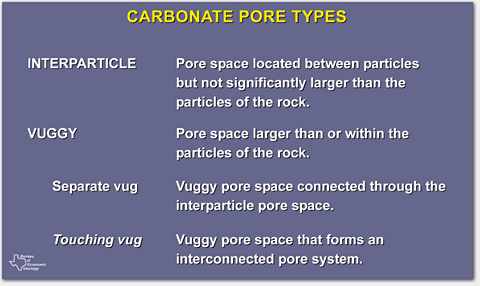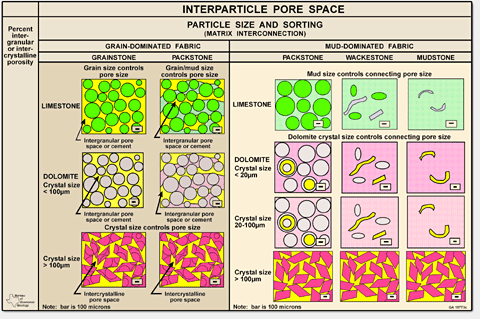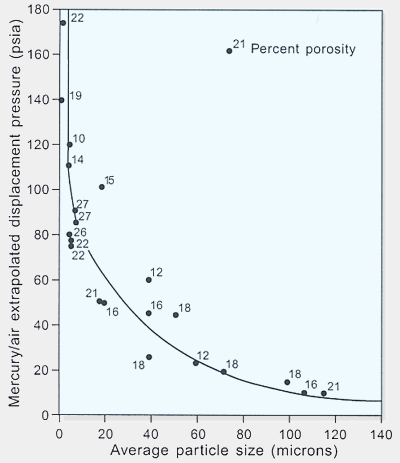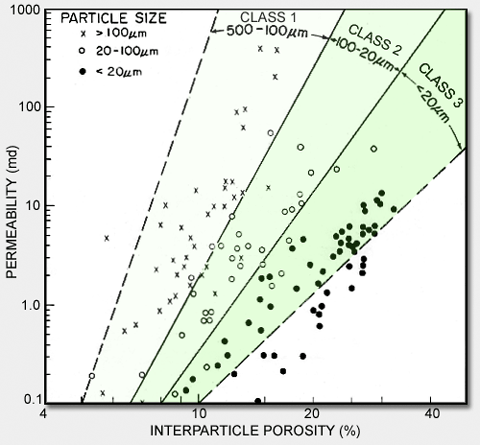
Estimating Permeability in Carbonates Using the Rock-Fabric Method
F. Jerry Lucia
Bureau of Economic Geology
| Design Objectives |
| Glossary |
| Credits |
| Back |
| Top |
| Exit |
 |
 |
 |
| Rock-Fabric
Classification
The classification used here has been presented by Lucia (1983, 1995, 1999). The foundation of the Lucia classification is the concept that pore-size distribution controls permeability and saturation and that pore-size distribution is related to rock fabric. Lucia (1983) showed that the most useful method of characterizing rock fabrics petrophysically is to divide pore types into pore space located between grains and crystals, called interparticle porosity, and all other pore space, called vuggy porosity (Fig. 2). Interparticle porosity is defined as pore space located between grains or crystals and is not significantly larger that than the particles. Vuggy porosity is pore space that is within grains or crystals or that is significantly larger than grains or crystals; that is pore space that is not interparticle. Vuggy pore space is further subdivided into two groups based on how the vugs are interconnected; (1) vugs that are interconnected only through the interparticle pore network are termed separate vugs and (2) vugs that form an interconnected pore system are termed touching vugs. Vugs are commonly present as dissolved grains, fossil chambers, fractures, and large irregular cavities. Although fractures may not be formed by depositional or diagenetic processes, fracture porosity is included because it defines a unique type of porosity in carbonate reservoir rocks.
In order to relate carbonate rock fabrics to pore-size distribution, it is important to 1) determine which of the three major pore-type classes are present, interparticle, separate-vug, or touching-vug, 2) measure the volume (porosity) of interparticle and separate-vug pore space, and 3) characterize the rock fabric of each pore type petrophysically. Classification of Interparticle Pore Space Interparticle porosity is defined as pore space located between grains or crystals that is not significantly larger than the particles (generally <2 x particle size). The pore-size distribution can be described in terms of particle size, sorting and interparticle porosity (Fig. 3). The volume of interparticle pore space is important because it relates to pore-size distribution.
Lucia (1983) showed that particle size can be related to mercury capillary displacement pressure in nonvuggy carbonates with more than 0.1 md permeability, suggesting that particle size describes the size of the largest pores (Fig. 4). Whereas the displacement pressure characterizes the largest pore sizes and is largely independent of porosity, the shape of the capillary pressure curve characterizes the smaller pore sizes and is dependent on interparticle porosity (Lucia 1983
The relationship
between displacement
pressure and particle size (Fig. 4) is hyperbolic and suggests
important particle-size boundaries at 100 and 20 m. Lucia (1983)
demonstrated that three permeability
fields can be defined using particle-size boundaries of 100 and
20
Recent work has shown that permeability classes can be better described in geologic terms if sorting as well as particle size is considered. The approach to size and sorting used in this petrophysical classification is similar to the grain-/mud-support principle upon which the Dunham's (1962) classification is built. Dunham's classification, however, is focused on depositional texture whereas petrophysical classifications are focused on contemporary rock fabrics which include depositional and diagenetic textures. Therefore, minor modifications must be made in Dunham's classification before it can be applied to a petrophysical classification. Instead of dividing
fabrics into grain support and mud support as in Dunham's classification,
fabrics are divided into grain-dominated and mud-dominated (Fig.
3). The important attributes of grain-dominated
fabrics are the presence of open or occluded intergrain porosity
and a grain-supported texture. The important attribute of mud-dominated
fabrics is that the areas between the grains are filled with
mud even if the grains appear to form a supporting framework. Grainstone
= grain supported with no intergrain lime mud present. |



